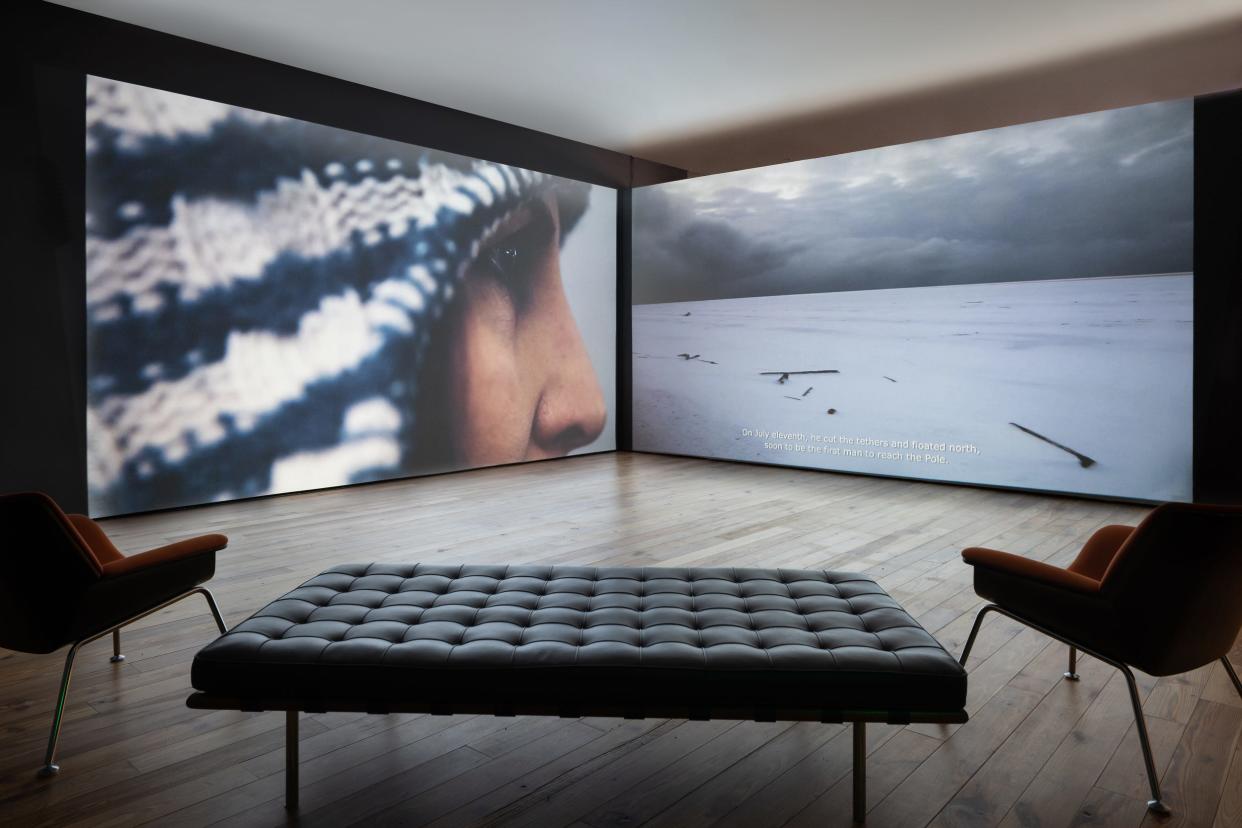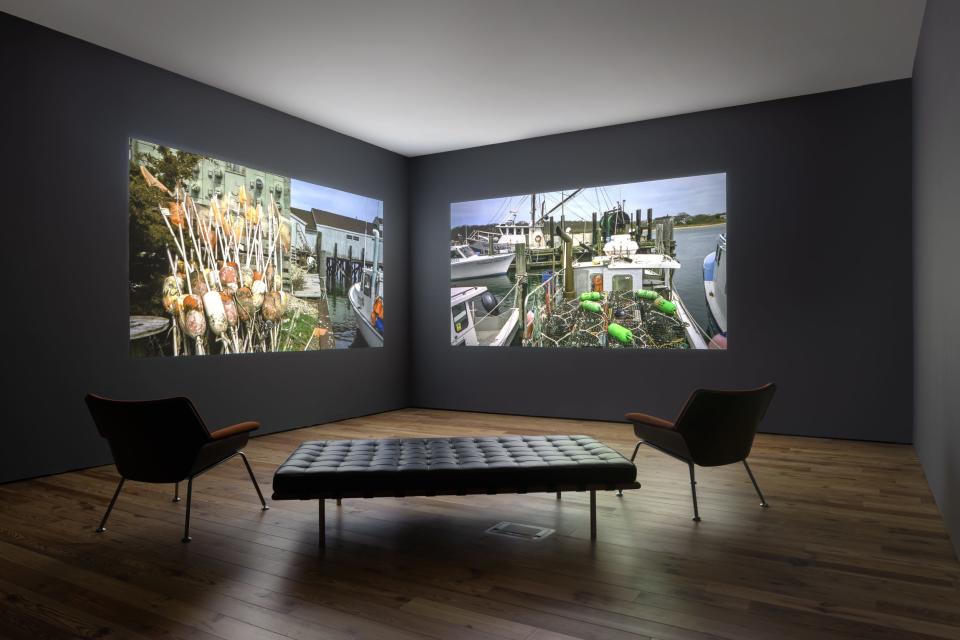Video visionaries create new ways of seeing in Sarasota Art Museum exhibit

- Oops!Something went wrong.Please try again later.
- Oops!Something went wrong.Please try again later.
Free afternoon, but your heart is torn. Watch a movie or videos? Or go to an exhibition and experience visual art? Sarasota Art Museum lets you can have it both ways. “Journeys to Places Known and Unknown,” the visual art is video art. The artists are peter campus and Janet Biggs.
These video visionaries came of age in different times and places, and worked with different tools. They didn’t always see eye to eye. But they’ve been aiming their cameras at the same thing for years: Time, as applied to living systems. Both use the moving image as a way of exploring the cycles of organic time. Both use the power of video to capture time at slower and faster rates than normal human perception.
Curator Terrie Sultan organized this exhibition around their common field of vision. But she doesn’t put their work side by side. One set of galleries is dedicated to campus’ videos; another to Biggs’ work. Each gallery showcases a vid series, with multiple screens playing at once. Other than that, it’s a random access art show. There’s no fixed path. After getting off the elevator, you can wander left, right, or any way you choose. But watch your step. As video art creates its own illumination, the museum turned the lights down low.
Arts Newsletter: Sign up to receive the latest news on the Sarasota area arts scene every Monday
Art, theater, dance, music and more: Your November guide to the arts in the Sarasota-Manatee area
Marty GrandPre: ‘Harry Potter’ illustrator talks new Sarasota abstract art show, retirement, J.K. Rowling

Janet Biggs
This artist’s videography has taken her to the global frontlines of climate change. Biggs shines a light on humanity’s threat to nature. She also shows how nature can return the compliment.
“Somewhere Beyond Nowhere” (2013) takes a walk on Mother Nature’s cold side. “Beyond Nowhere” turns out to be Svalbard, an archipelago halfway between northern Europe and the North Pole. Thanks to humanity, this scene of magnificent desolation may vanish. But this beautiful landscape can also kill any visiting human who doesn’t respect its dangers. The artist seems particularly alone and vulnerable in a video of her visit. Biggs wanders up to a sheet of ice, a smooth flat plane, with jagged mountains in the background. She fires a flare and it arcs across the ice and sizzles on the other side. It seems anticlimactic. Up here “beyond nowhere,” nobody would notice. Biggs then relates the tales of other Arctic expeditions. S. A. Andrée’s story is the most gripping. He’d planned to sail a balloon to the North Pole with two other balloonists. He’d brought along a tuxedo for photos of his triumphant arrival. The balloon floated off. And was never seen again.
“Entanglements” refers both to quantum entanglement and cross-disciplinary creativity. This series reflects Biggs’ joint effort with mathematician Agnieszka Miedlar, physicist Daniel Tapia Takaki, and two participating artists. The resulting videos offer glimpses of CERN’s Large Hadron Collider (the world’s largest, strongest particle accelerator) and a high-energy physics equation on a whiteboard. With the aid of verbal prompts, Vinson Fraley translates the abstract equations into dance movements; violinist Earl Maneein interprets the records of particle collisions as a music score; and they both respond to each other. Biggs intersperses these enigmatic feedback loops with manipulated video footage resembling the “Star Gate” sequence in “2001.”
‘Wilkommen’: Asolo Rep opens new season with a fresh take on ‘Cabaret’
Love letter to musical theater: ‘Something Rotten’ toys with Shakespeare at Florida Studio Theatre
On the walls this fall: 5 must-see fall visual art exhibits coming to the Sarasota area

peter campus
In 1971, this pioneering video artist created his first black-and-white video with bulky, portable gear. Technology changed in the decades that followed; campus changed with it. In fact, change at very slow rates seems to be a recent fascination.
“when the hurly burly’s done” comprises nine videos playing on separate screens. Each video loop represents the viewpoint of one fixed camera. To capture this footage, the artist positioned nine vid cams around the shores of Shinnecock Bay in upstate New York. He let them record over the course of a year, then distilled the footage for the looping videos. The resulting scenes have the Zen quality of “nothing special.” A duck blind floating on the water. A scattering of fallen leaves and beach grass by an isolated tree. It’s all so ordinary, it’s extraordinary. It’s also the kind of information the human mind tends to filter out. We think we’ve seen it before, so we don’t need to look.
But mechanical recording devices don’t suffer from human impatience. To quote the artist’s poetic statement: “the camera is independent of me, i walk away while it's recording. it sees in a way i can't: in greater detail, with more patience.”
The video camera “sees” with its unblinking eye. But the artist sees, as well. The artist’s mind transforms the mechanical vision into art.
“ebb and flow” reveals the same parallax view in a montage of scenes. Fishing boats. Hardworking fishermen. A skipper docking his boat at day’s end. The snarled grid of an angry red safety net, entangling a fence. This imagery alternates from Montauk Harbor to New Bedford Harbor to Hampton Bays near the Shinnecock Inlet. The artist describes this series as “a triptych in time.” But it’s presented on two screens that aren’t always in synch or from the same point of view. Even knowing this, your mind stitches the scenes into a whole anyway. It’s how binocular vision works.
Biggs and campus created these videos separately over several years. They collaborated on the structure of this exhibit for more than a year. As this happened in the time of COVID, this began with Zoom collaborations. It ended with a real-world on-site visit by both artists.
I thought this review would be easy. I was wrong. As a reviewer and sometime graphic designer, I aim for strong single images. The chase I want to cut to. The synecdoche that sums it all up.
This exhibition doesn’t work that way.
There are strong images. But the images constantly move. And each video informs every other video, and the entire experience exists in time. It’s a symphony of images. To appreciate each part, you have to appreciate the whole.
It’s a new way of seeing. To really see this exhibit, you have to open your eyes.
“Journeys to Places Known and Unknown: Moving Images by Janet Biggs and peter campus”
Through Jan. 15 at Sarasota Art Museum, 1001 South Tamiami Trail, Sarasota; (941) 309-4300; sarasotaartmuseum.org
This article originally appeared on Sarasota Herald-Tribune: Video visionaries take Sarasota Art Museum visitors on timely journey

